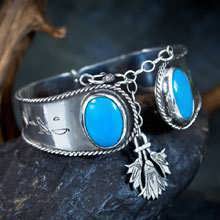
Braccialetto Ka - argento
Ancient Egyptian Symbol of the Life Force
Understand and appreciate the eternity of the soul
The term "Ka" in the ancient Egyptian culture meant "life force", which incarnate in the physical body the "Ba". As a Sun cult, the Egyptians used the symbol of the Blue Lotus Flower. In ancient Egypt, the Lotus flower was used in many religious rituals probably because of the mild psychoactive properties of this plant (the Blue lotus of the Nile-Nymphaea caerulea, also known as the Blue Egyptian water lily or sacred blue lily, is a water-lily in native to Egypt).
The Egyptian Lotus symbol was used as a symbol of the Sun and the afterlife since it's flower buds rise to the surface of the water over a period of 2-3 days and when ready open in the morning and then close in the afternoon.
A translation of the hieroglyphs engraved on the bracelet is: "Rise up and awaken, you are not dead, your Ka will remain within you for eternity".
The beautiful Lotus flower was also depicted as the original container from which Atom, the god of creation or the creator himself came into existence. Atum was considered to be the first god, having created himself, sitting on a mound from the primordial waters. Atum is the god of pre-existence and post-existence. In the binary solar cycle, the serpentine Atum is contrasted with the ram-headed scarab Khepri - the young sun god, whose name is derived from the Egyptian hpr "to come into existence". Khepri-Atum encompassed sunrise and sunset, thus reflecting the entire solar cycle.
The Ka bracelet itself is inlaid with semi-precious stones that were used by the ancient Egyptians, such as Jasper that was worn for protection or Turquoise, Lapis Lazuli and Onyx.